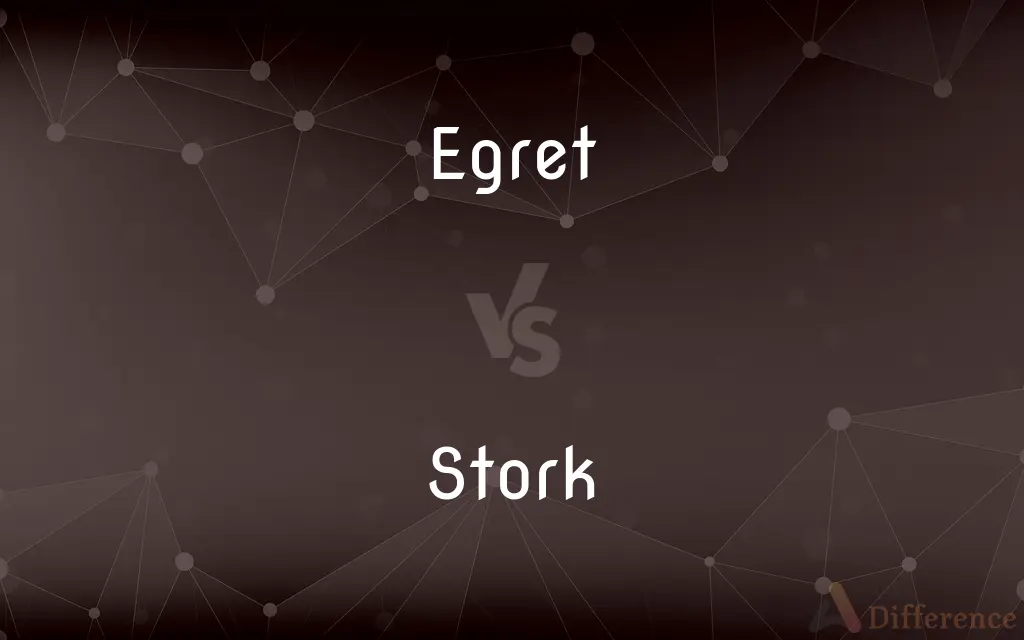Egret vs. Stork — What's the Difference?
Edited by Tayyaba Rehman — By Fiza Rafique — Updated on November 3, 2023
Egrets are usually smaller, white herons with long legs and necks, while storks are larger, wading birds with heavier bills.

Difference Between Egret and Stork
Table of Contents
ADVERTISEMENT
Key Differences
Egrets are wading birds known for their slender build, belonging to the heron family Ardeidae. They are usually white and often develop fine plumes during the breeding season. Storks, on the other hand, are larger wading birds from the family Ciconiidae, characterized by their long necks, legs, and straight, pointed bills, which are usually heavier than those of egrets.
An egret's habitat is commonly around wetlands, marshes, and riverbanks where they hunt for fish, frogs, and insects. Storks also inhabit similar wetland environments but are known to venture into savannas and pastures. Both egrets and storks are seen as symbols of good luck in various cultures, but storks have a stronger association with birth and family due to the folklore of delivering babies.
The breeding behaviors of egrets involve elaborate displays, utilizing their ornamental feathers. Storks are famous for their large stick nests that they often build on buildings or trees and use for several years. While both birds are monogamous during the breeding season, storks may pair for life, which is less common in egrets.
Egrets are more likely to be found in both freshwater and saltwater habitats, whereas storks have a preference for freshwater environments. The egret's diet is quite varied but they mainly feed on aquatic prey, which they catch after standing still and waiting for the prey to come near. Storks are more opportunistic and will eat a wider variety of animals, including insects, fish, amphibians, reptiles, and small mammals.
Conservation status for egrets and storks varies by species, with some egret species having been hunted nearly to extinction for their feathers in the past. Storks, with their larger size and different feeding habits, face different conservation challenges, often related to habitat destruction and collision with power lines.
ADVERTISEMENT
Comparison Chart
Family
Ardeidae (herons)
Ciconiidae (storks)
Size
Generally smaller, slimmer
Larger with a heavier build
Bill Shape
Slimmer and pointed
Heavier and straighter
Breeding Plumage
Develop fine plumes during breeding season
Lack ornamental plumes
Symbolism
Grace and purity
Birth and family
Compare with Definitions
Egret
An egret is a white wading bird with long legs and a slender neck.
The egret stood silently by the water's edge, waiting to strike at a fish.
Stork
The stork's strong bill is an essential tool for foraging and nest building.
With its bill, the stork meticulously arranged twigs to fortify its nest.
Egret
Egrets are often found in wetlands and are skilled aquatic hunters.
An egret plunged its head into the water and emerged with a wriggling fish.
Stork
Many stork species are monogamous and use the same nests each year.
The pair of storks returned to refurbish their nest atop the old chimney.
Egret
In breeding season, egrets display beautiful ornamental feathers.
The breeding egrets displayed their plumes proudly in the nest colony.
Stork
Storks are known for their migratory habits, traveling vast distances.
A flock of storks passed overhead, signaling the change of the season.
Egret
The Great Egret is a large species of egret with an impressive wingspan.
A Great Egret took flight, overshadowing the smaller birds on the lake.
Stork
A stork is a tall, long-legged wading bird often associated with folklore.
The white stork circled above the village, a common sight in the spring.
Egret
Egrets are herons that have white or buff plumage, developing fine plumes (usually milky white) during the breeding season. Egrets are not a biologically distinct group from herons and have the same build.
Stork
Storks are large, long-legged, long-necked wading birds with long, stout bills. They belong to the family called Ciconiidae, and make up the order Ciconiiformes .
Egret
Any of several usually white herons of the genera Ardea, Bubulcus, and Egretta, characteristically having long, showy plumes during the breeding season.
Stork
Any of various large wading birds of the family Ciconiidae, having long legs and a long straight bill.
Egret
Any of various wading birds of the genera Egretta or Ardea that includes herons, many of which are white or buff, and several of which develop fine plumes during the breeding season.
Stork
A large wading bird with long legs and a long beak of the family Ciconiidae.
Egret
A plume or tuft of feathers worn as a part of a headdress, or anything imitating such an ornament.
Stork
(children's folklore) The mythical bringer of babies to families, or good news.
Egret
(botany) The flying feathery or hairy crown of seeds or achenes, such as the down of the thistle.
Stork
(cartomancy) The seventeenth Lenormand card.
Egret
(obsolete) The crab-eating macaque (Macaca fascicularis)
Stork
Any one of several species of large wading birds of the family Ciconidæ, having long legs and a long, pointed bill. They are found both in the Old World and in America, and belong to Ciconia and several allied genera. The European white stork (Ciconia alba) is the best known. It commonly makes its nests on the top of a building, a chimney, a church spire, or a pillar. The black stork (C. nigra) is native of Asia, Africa, and Europe.
Egret
The name of several species of herons which bear plumes on the back. They are generally white. Among the best known species are the American egret (Ardea egretta syn. Herodias egretta); the great egret (Ardea alba); the little egret (Ardea garzetta), of Europe; and the American snowy egret (Ardea candidissima).
A bunch of egrets killed for their plumage.
Stork
Large mostly Old World wading birds typically having white-and-black plumage
Egret
A plume or tuft of feathers worn as a part of a headdress, or anything imitating such an ornament; an aigrette.
Stork
Storks feed on a wide range of prey, from insects to small animals.
In the field, a stork jabbed at the ground, hunting for earthworms.
Egret
The flying feathery or hairy crown of seeds or achenes, as the down of the thistle.
Egret
A kind of ape.
Egret
Any of various usually white herons having long plumes during breeding season
Egret
Egrets are known for their graceful movements and elegant stature.
Egrets danced in the marshland at sunrise, captivating the birdwatchers.
Common Curiosities
Do egrets mate for life?
Egrets typically do not mate for life, unlike some stork species.
What do storks symbolize?
Storks are often symbols of good luck, fertility, and family.
Can egrets and storks be found in the same habitats?
Yes, both can be found in wetlands but storks are less common in saltwater habitats.
How many species of egrets are there?
There are several species of egrets within the heron family.
Why are storks associated with babies?
Folklore suggests storks deliver babies, stemming from the bird's springtime return to nesting sites.
What's unique about the way storks build nests?
Storks build large, sturdy nests that they often reuse each year.
What differentiates an egret from a stork?
Egrets are smaller, often white, and belong to the heron family, while storks are larger with heavier bills.
Are all egrets white?
Most egrets are white, but some species have different colorations.
Are egrets or storks better flyers?
Both are proficient flyers, but storks are particularly known for long-distance migration.
What do storks eat?
Storks eat a variety of foods, including insects, fish, and small vertebrates.
Are egret populations at risk?
Some egret species have faced challenges but conservation efforts have helped their recovery.
What role do storks play in their ecosystems?
Storks help control populations of pests and are indicators of a healthy environment.
Are egrets social birds?
Egrets can be quite social, especially during the breeding season when they nest in colonies.
Do egrets migrate?
Some egret species migrate, while others remain in the same area year-round.
Do storks have any predators?
Adult storks have few natural predators due to their size, but eggs and young can fall prey to other animals.
Share Your Discovery

Previous Comparison
Borough vs. Township
Next Comparison
Shovel vs. SpadeAuthor Spotlight
Written by
Fiza RafiqueFiza Rafique is a skilled content writer at AskDifference.com, where she meticulously refines and enhances written pieces. Drawing from her vast editorial expertise, Fiza ensures clarity, accuracy, and precision in every article. Passionate about language, she continually seeks to elevate the quality of content for readers worldwide.
Edited by
Tayyaba RehmanTayyaba Rehman is a distinguished writer, currently serving as a primary contributor to askdifference.com. As a researcher in semantics and etymology, Tayyaba's passion for the complexity of languages and their distinctions has found a perfect home on the platform. Tayyaba delves into the intricacies of language, distinguishing between commonly confused words and phrases, thereby providing clarity for readers worldwide.















































